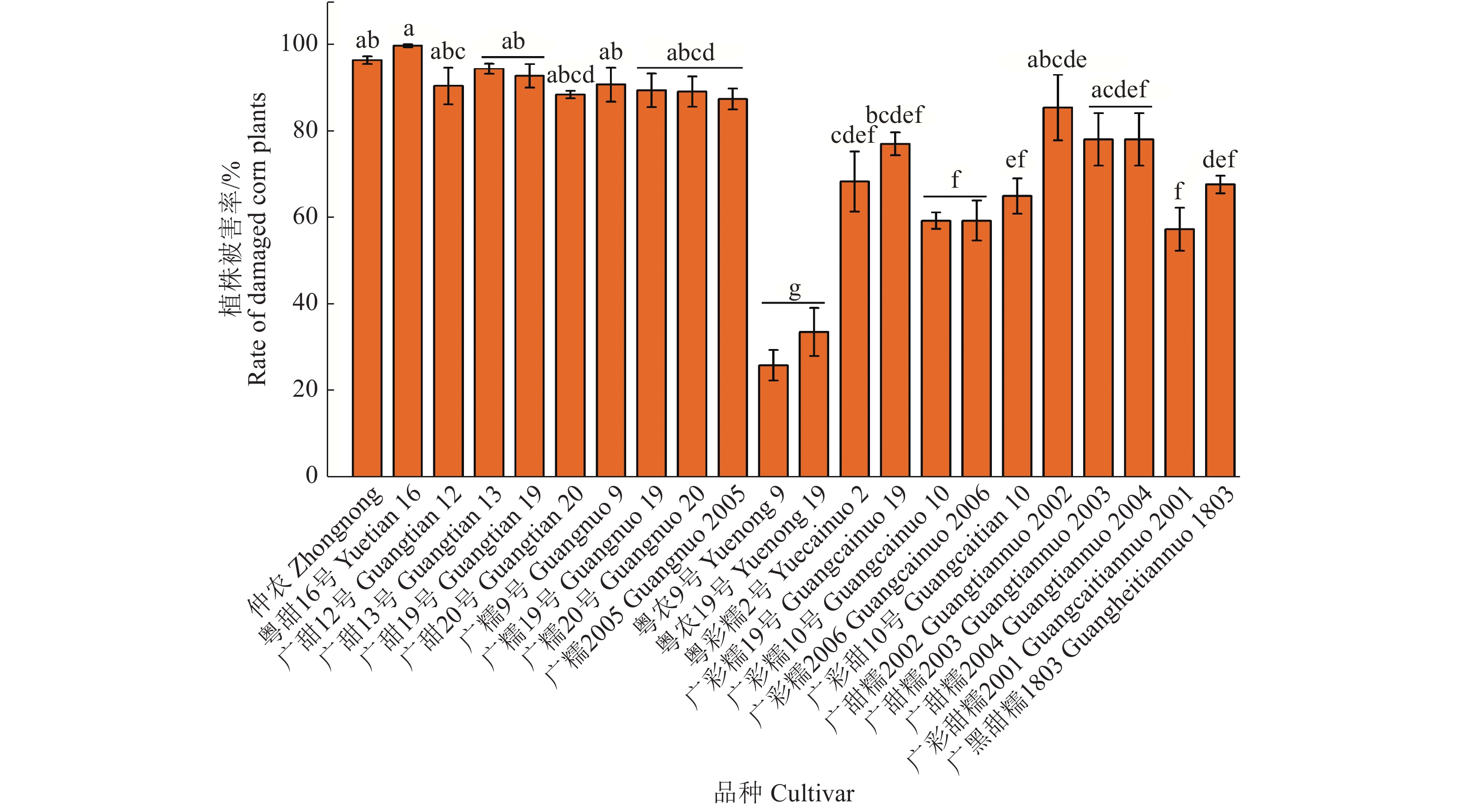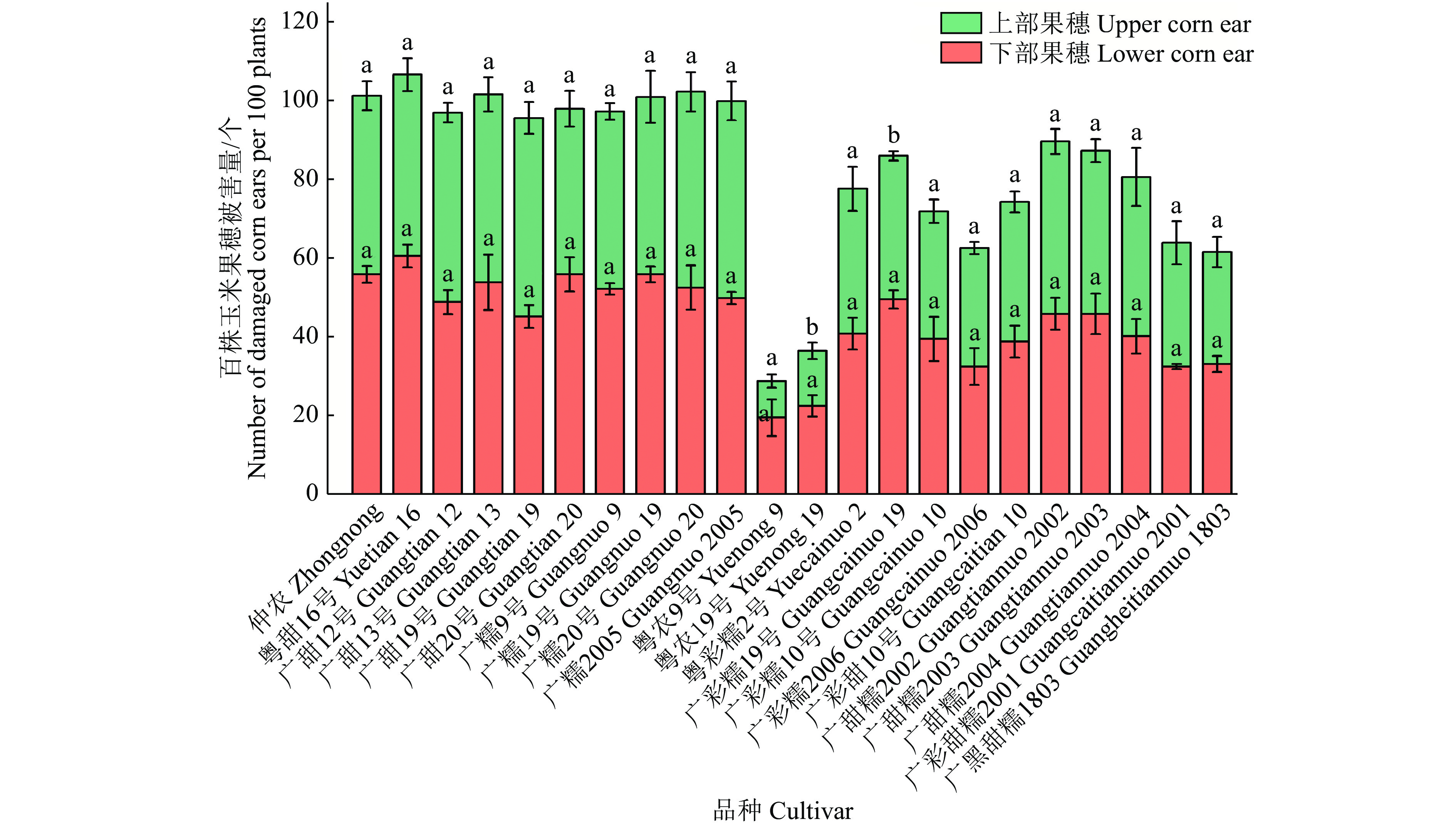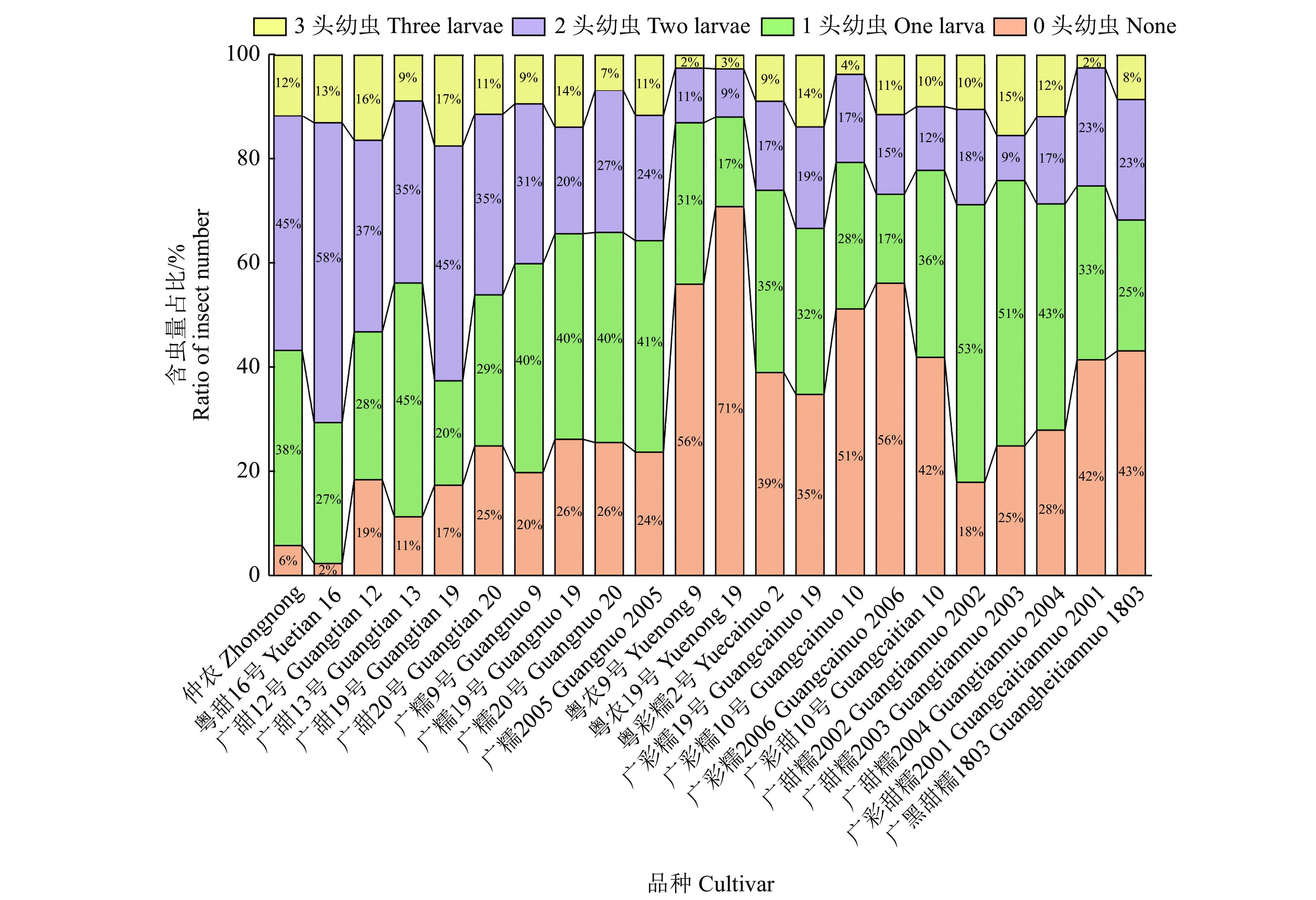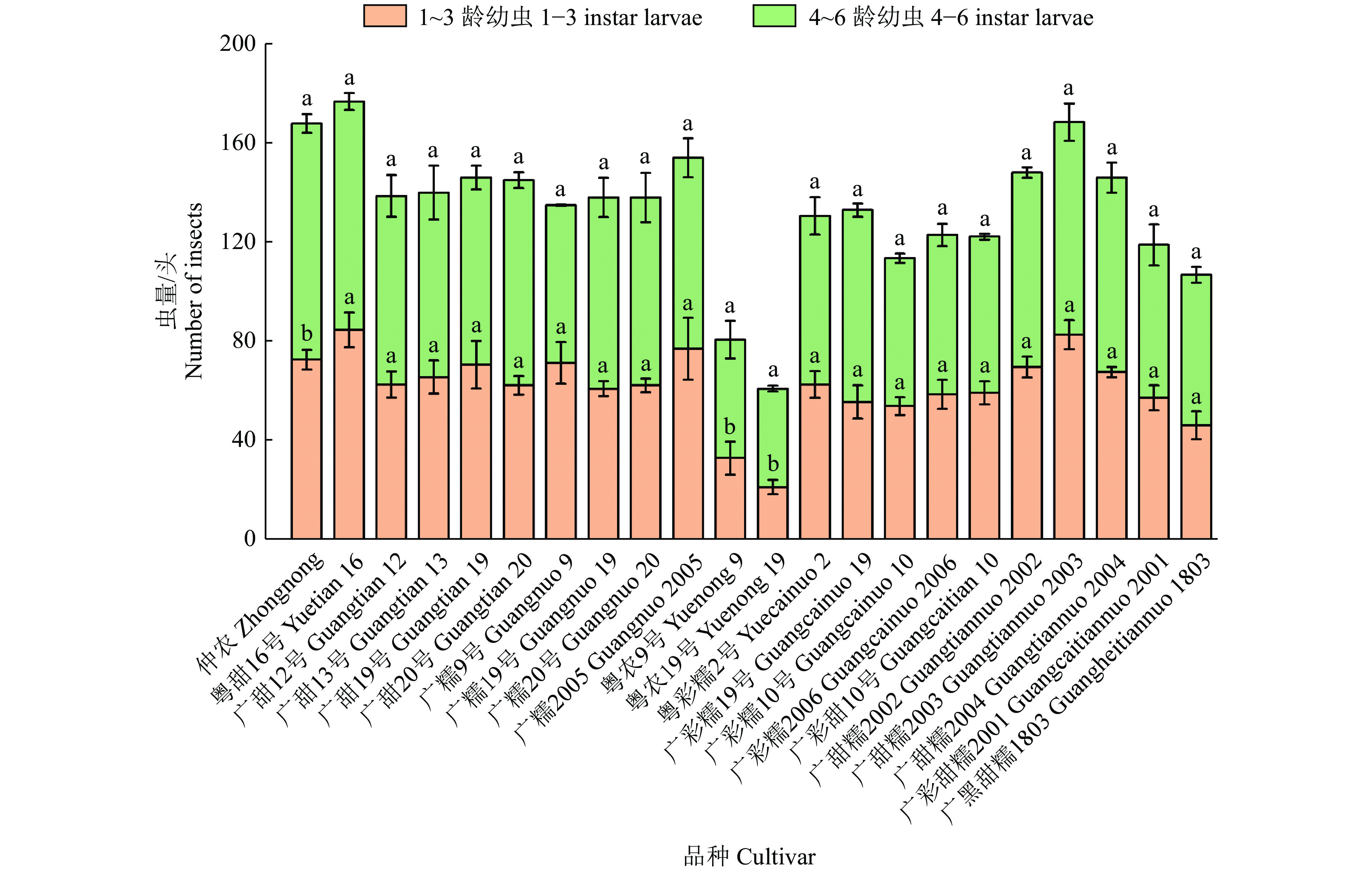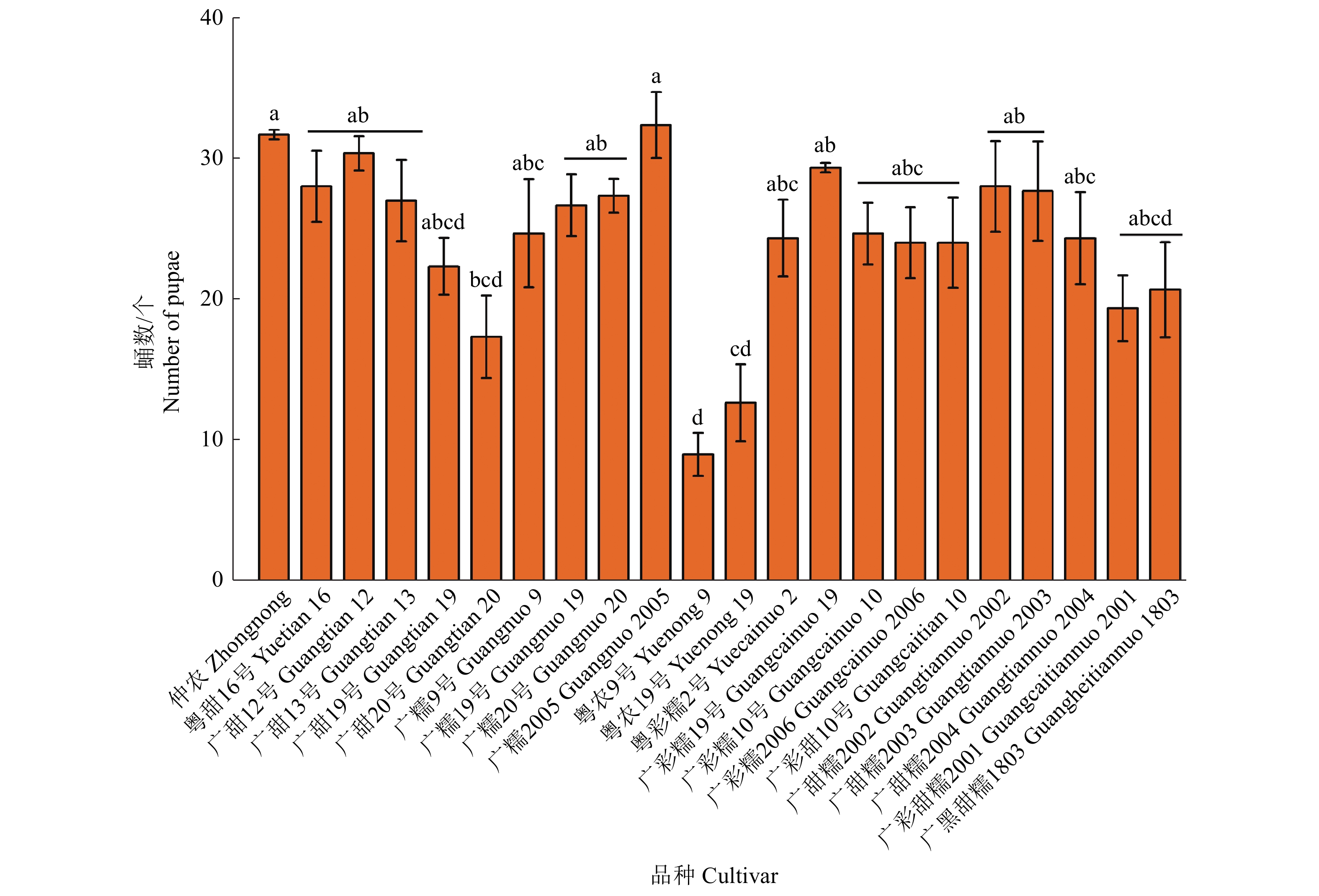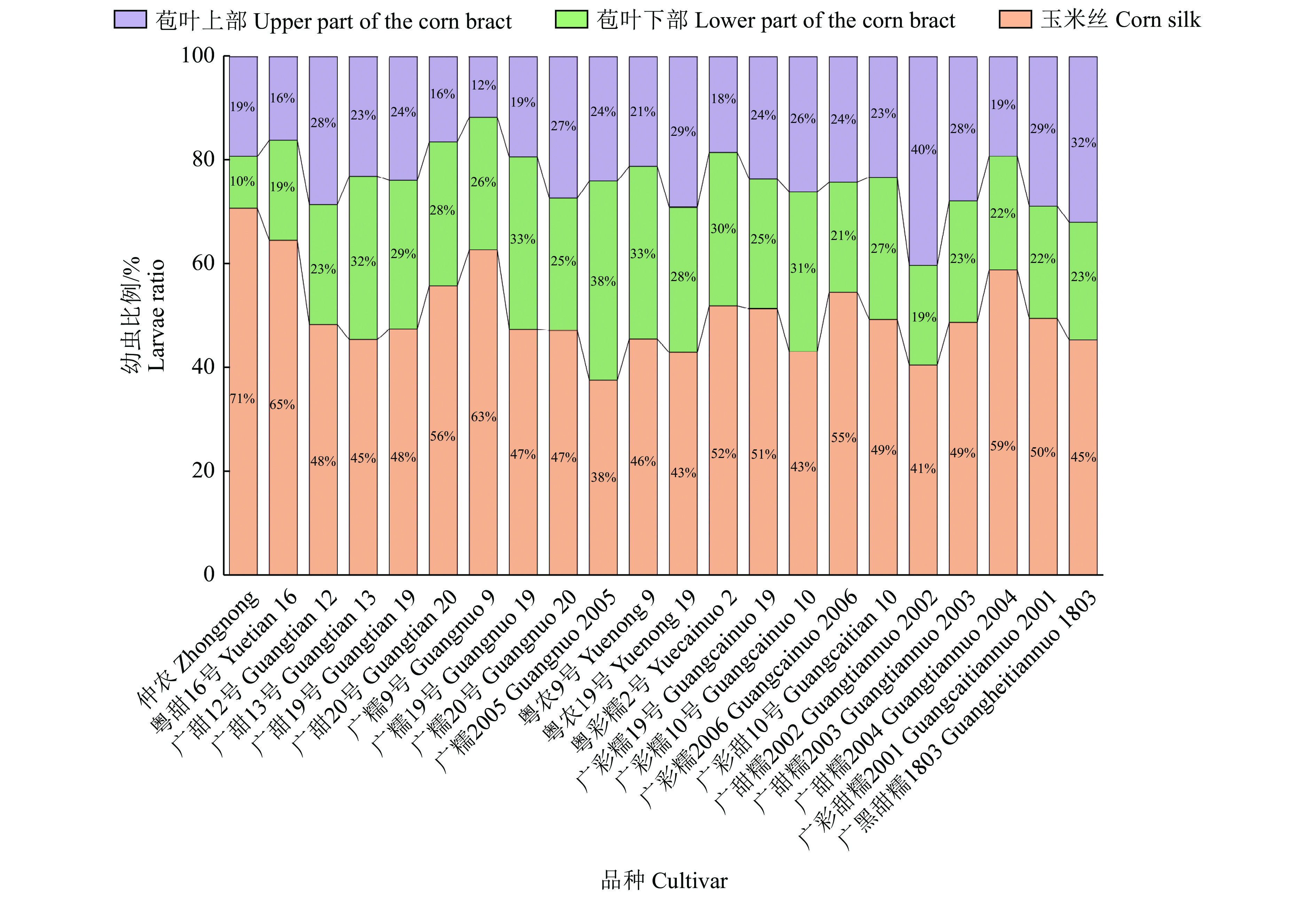Study on the damage of Spodoptera frugiperda to ears of different maize cultivars
-
摘要:目的
调查草地贪夜蛾Spodoptera frugiperda对广东省广泛种植的22个玉米品种果穗的为害情况。
方法采用“Z”字形五点取样法调查玉米果穗被害情况。记录每株玉米上部和下部果穗被害情况,包括玉米果穗中的1~3龄、4~6龄幼虫、活虫和蛹的数量,以及玉米果穗上被幼虫钻蛀的位置。
结果草地贪夜蛾在不同品种玉米上的为害均较为严重,所有品种的植株被害率均大于25%,但不同品种的被害程度存在明显差异。甜玉米受害最严重,其中,‘粤甜16号’的被害率高达99.67%。除‘粤农19号’、‘广彩糯19号’外,其他品种的玉米上、下部果穗的被害情况差异不显著(P>0.05)。绝大部分玉米果穗中存在草地贪夜蛾幼虫,含有1~2头幼虫的果穗比例为26%~85%,含有3头幼虫的果穗比例仅为2%~17%,未在同一果穗内发现3头以上的幼虫。除‘广糯9号’和‘广糯2005’外,其他品种的玉米中发现的4~6龄幼虫数量均要多于1~3龄幼虫。38%~71%草地贪夜蛾幼虫都是从玉米丝钻入玉米果穗内为害并在果穗内化蛹,平均每百株果穗的蛹为9~32个。
结论草地贪夜蛾偏爱取食甜玉米和糯玉米并在其果穗内化蛹,对饲料玉米的为害较轻。1~3龄和4~6龄幼虫在玉米乳熟期的取食行为相同,都喜爱从玉米丝钻入果穗内为害。研究结果可为选育玉米抗性品种和草地贪夜蛾的精准防控提供参考。
Abstract:ObjectiveTo investigate the damage of Spodoptera frugiperda to ears of 22 maize cultivars widely planted in Guangdong Province.
MethodThe damage of corn ear was investigated by “Z” shaped five-point sampling method. The damage of the upper and lower corn ears of each plant, including the numbers of 1st to 3rd instar larvae, 4th to 6th instar larvae, live insects, live pupae and the damage position drilled by larvae were recorded.
ResultTwenty-two maize cultivars were all damaged seriously by S. frugiperda and the ratios of damaged plants were higher than 25% for all cultivars, while there were significant differences in damage degree among different cultivars. The sweet corns suffered the most serious damage compared to other cultivars, especially the ratio of damaged plants of ‘Yuetian 16’ was up to 99.67%. There was no significant difference in damage between the upper and lower corn ears for each cultivar except ‘Yuenong 19’ and ‘Guangcainuo 19’. Majority of corn ears had S. frugiperda larvae and the ratio of corn ear containing 1 and 2 larvae was 26% − 85%, the ratio of corn ear containing 3 larvae was 2% − 17%, while no corn ear was found to have more than 3 larvae. The number of 4th to 6th instar larvae was higher than that of 1st to 3rd instar larvae for each cultivar except ‘Guangnuo 9’ and ‘Guangnuo 2005’. Ranging from 38% to 71% S. frugiperda larvae entered into corn ear from corn silk and pupated, and the average number of pupae per 100 plants were 9−32.
ConclusionS. frugiperda prefer to eat sweet corn and waxy corn and pupate in their ears, while the damage to feed corn is relatively light. The 1st−3rd and 4th−6th instar larvae of S. frugiperda have the same feeding behavior during the milky stage of corn and they prefer to enter into corn ear from corn silk and damage corn. The results can provide references for breeding resistant corn cultivars and precise control of S. frugiperda.
-
Keywords:
- Spodoptera frugiperda /
- corn cultivar /
- ear /
- feeding behavior
-
苦楝Melia azedarach又名翠树、楝树、紫花树、森树等,为楝科楝属落叶乔木,分布于中国、韩国、日本、印度、斯里兰卡、印度尼西亚和澳大利亚等地,欧洲、美洲也有栽培[1].苦楝在我国分布广泛,水平分布为北纬18° ~ 40°,南至海南省崖县,北到河北保定和山西运城、陕西渭南、陇南地区,东至台湾、沿海各省,西到四川、云南保山[2].它生长速度快、木材材质优良、纹理美丽,易加工,可用于家具、建筑、农具、船舶、乐器制作等方面,木材抗白蚁、抗虫蛀、耐腐.苦楝耐烟尘,能大量吸收有毒有害气体,是优良的城市及工矿区绿化树种,也是我国南方四旁绿化常用树种[3-4].苦楝的根、皮、花、果均可入药,也可作为植物源农药[5].遗传多样性是生物多样性的重要组成部分,SRAP(Sequence-related amplified polymorphism,相关序列扩增多态性)结合了AFLP及RAPD各自的优点,方便快速,只需要极少量DNA材料,且不需要预先知道DNA序列信息,即可快速获得大量的信息,试验结果稳定可靠,且再现性较高,重复性较好[6-7].目前为止,国内对于苦楝的遗传多样性分析,鲜见开展过SRAP的研究.本试验采用单因素和正交试验设计从DNA、dNTPs、Mg2+、引物和TaqDNA聚合酶5个组分浓度对苦楝SRAP-PCR反应体系进行优化,旨在寻找一种高效、快速、经济的试验方法,建立适合苦楝的SRAP-PCR反应体系,为进一步应用SRAP技术对苦楝群体遗传多样性、种质资源鉴定等研究提供参考[7].
1. 材料与方法
1.1 材料
苦楝幼叶于2013年7月取自华南农业大学苗圃,随用随采,用于苦楝基因组DNA的提取,采集叶片分别为海南三亚、广东兴宁、广西梧州、福建建瓯、江西南昌、安徽利辛、陕西蒲城、河北邯郸种源.所用正向引物序列为Me19(TGAGTCCAAACCGGTTG)和Me27(TGGGGACAACCCGGCTT),反向引物序列为Em2(GACTGCGTACGAATTTGC)、Em4(GACTGCGTACGAATTTGA)和Em5(GACTGCGTACGAATTAAC).
1.2 主要试剂和仪器
用于SRAP-PCR反应的Taq酶、dNTPs、Mg2+为TaKaRa公司产品,引物由北京华大基因研究中心合成,PCR反应在东胜创新生物技术有限公司的PCR扩增仪上进行,DNA浓度和纯度使用超微量紫外分光光度计(Thermo Nanodrop 2000)检测.
1.3 基因组DNA的提取
苦楝基因组DNA提取参照上海生工生物工程有限公司柱式基因组DNA提取试剂盒说明书进行.所提取的基因组DNA用8 g·L-1琼脂糖凝胶电泳检测品质,并采用超微量紫外分光光度计检测DNA的浓度和纯度,然后将DNA稀释至50 ng·μL-1,置于-20 ℃条件下保存备用.
1.4 PCR扩增
SRAP-PCR反应程序为:94 ℃预变性5 min;94 ℃变性1 min,35 ℃复性1 min,72 ℃延伸1 min,5个循环;94 ℃变性1 min,50 ℃复性1 min,72 ℃延伸1 min,30个循环;72 ℃延伸10 min.扩增产物采用20 g·L-1的琼脂糖凝胶电泳,电泳后在自动凝胶图像分析仪上拍照分析.
1.5 PCR反应体系单因素分析
对影响苦楝SRAP-PCR反应的主要因素(模板DNA、dNTPs、Mg2+、引物和Taq酶)进行单因子试验.对各影响因子分别设置8个梯度处理:模板DNA为0、10、20、30、40、50、60和70 ng;dNTPs为0、0.05、0.10、0.15、0.20、0.25、0.30和0.35 mmol · L-1;Mg2+为0、1.0、1.5、2.0、2.5、3.0、3.5和4.0 mmol·L-1;引物为0、0.16、0.24、0.32、0.40、0.48、0.56和0.64 μmol·L-1;Taq DNA聚合酶为0、0.50、0.75、1.00、1.25、1.50、1.75和2.00 U.
1.6 PCR反应体系的正交试验
在对影响苦楝SRAP-PCR反应的模板DNA、dNTPs、Mg2+、引物和Taq酶进行单因子试验后采用L16(45)正交试验设计,共16个处理,每个处理设2个重复,各因素水平见表 1.根据电泳条带的多少、清晰度及背景颜色进行打分.最优的得5分,最差的得1分,并计算每个因素在不同水平下的平均得分[8].
表 1 SRAP-PCR正交试验设计L 16(45)及试验结果Table 1. L 16(45) Orthogonal designs and results of SRAP-PCR reaction
2. 结果与分析
2.1 单因素试验分析
以SRAP-PCR反应产物电泳得到的条带数目较多且清晰为筛选原则,对反应体系中起主要作用的5个因素进行单因素浓度梯度筛选试验[9-12],每个因素设置8个浓度梯度.试验结果表明:在25 μL反应体系中,模板DNA为25 ~ 40 ng、dNTPs为0.125 ~ 0.200 mmol·L-1、Mg2+为1.75 ~ 2.25 mmol·L-1、引物为0.40 ~ 0.52 μmol·L-1、Taq DNA聚合酶为0.50 ~ 1.25 U时扩增效果好,条带较多且清晰,故将其选为后续正交试验的适宜浓度范围.
2.2 苦楝SRAP-PCR正交反应体系的优化
以上述单因素试验确定的各因素适宜浓度范围为基础,采用L 16(45)正交设计对SRAP-PCR反应体系进行优化(表 1),并根据电泳条带的多少、清晰度及背景颜色(图 1)对16个处理进行打分,打分结果如表 1所示,从2次的得分来看,重复间差异不大,试验的一致性较好,其中处理5、处理7、处理8和处理9效果较好,评分均为4分,而处理15效果不好,评分仅为1.0分.从图 2可见,模板DNA 30 ng、dNTPs 0.125 mmol·L-1、Mg2+ 2.25 mmol·L-1、引物0.48 μmol·L-1、Taq DNA聚合酶0.75 U、反应总体积25 μL时得分较高,实现最佳扩增,确定为最优组合.
2.3 苦楝SRAP-PCR反应体系稳定性的检测
为了验证体系的准确性,以来自海南三亚、广东兴宁、广西梧州、福建建瓯、江西南昌、安徽利辛、陕西蒲城、河北邯郸的8个苦楝种源DNA为模板,选取引物Me27/Em2、Me27/Em4进行SRAP-PCR验证,其结果如图 3所示,每个种源对每个引物均有清晰的条带,且不同种源间条带有差异.由此可见,本试验建立的SRAP-PCR体系稳定可靠,适用于苦楝后续的SRAP分析.
3. 结论
本试验建立并优化了适应苦楝SRAP-PCR的反应体系,前期对苦楝模板DNA、Mg2+、引物和Taq酶进行单因子试验,研究发现,SRAP对苦楝DNA浓度的要求不高,有一个较宽的浓度适宜范围,在25 μL体系中,模板DNA为10 ~ 70 ng时都扩增出了较清晰、带型基本相同的谱带;dNTPs设计的8个浓度梯度中,0.1 ~ 0.2 mmol·L-1范围内能扩增出清晰谱带,且条带基本相同,浓度低于0.1 mmol·L-1时,扩增条带弥散,高于0.2 mmol·L-1时,出现条带丢失的现象;Mg2+为2.00 mmol·L-1左右时扩增条带较清晰且数量多;引物介于0.48 ~ 0.64 μmol·L-1之间均能产生较为清晰的条带,且带型基本上保持一致,条带数并没有随着浓度的增加而增加;Taq DNA聚合酶用量在0.50 ~ 2.0 U范围内均可以得到清晰的带型,对其用量要求不高.进一步对苦楝SRAP-PCR的反应体系进行正交试验,并根据电泳条带的多少、清晰度及背景颜色对16个处理进行打分,从2次的得分来看,重复间差异不大,试验的一致性较好,其中处理5、处理7、处理8和处理9效果较好,评分均为4.0分,而处理15效果不好,评分仅为1.0分.根据得分可知,在25 μL反应体系中,当模板DNA 30 ng、dNTPs 0.125 mmol·L-1、Mg2+ 2.25 mmol·L-1、引物0.48 μmol·L-1、Taq DNA聚合酶0.75 U时,实现最佳扩增,确定为最优组合.以来自海南三亚、广东兴宁、广西梧州、福建建瓯、江西南昌、安徽利辛、陕西蒲城、河北邯郸的8个苦楝种源DNA为模板,选取引物Me27/Em2、Me27/Em4进行SRAP-PCR反应体系稳定性验证,结果表明,筛选体系能很好地满足苦楝基因组SRAP-PCR扩增的要求且不同种源间条带有差异.
-
图 5 不同品种玉米果穗田间被害图
a:仲农;b:粤甜16号;c:广甜12号;d:广甜19号;e:广甜20号;f:广糯9号;g:广糯19号;h:广糯20号;i:广糯2005;j:粤农9号;k:粤农19号;l:粤彩糯2号;m:广彩糯19号;n:广彩糯10号;o:广彩糯2006;p:广彩甜10号;q:广甜糯2002;r:广甜糯2003;s:广甜13号;t:广甜糯2004;u:广彩甜糯2001;v:广黑甜糯1803;w:从玉米丝钻入;x:从玉米苞叶上部钻入;y:从玉米苞叶下部钻入
Figure 5. The damaged corn ears of different corn cultivars in field
a: Zhongnong;b: Yuetian 16;c: Guangtian 12;d: Guangtian 19;e: Guangtian 20;f: Guangnuo 9;g: Guangnuo 19;h: Guangnuo 20;i: Guangnuo 2005;j: Yuenong 9;k: Yuenong 19;l: Yuecainuo 2;m: Guangcainuo 19;n: Guangcainuo 10;o: Guangcainuo 2006;p: Guangcaitian 10;q: Guangtiannuo 2002;r: Guangtiannuo 2003;s: Guangtian 13;t: Guangtiannuo 2004;u: Guangcaitiannuo 2001;v: Guangheitiannuo 1803;w: Drill into corn ear from the corn silk;x: Drill into corn ear from the upper part of the corn bract;y: Drill into corn ear from the lower part of the corn bract
表 1 玉米品种名称
Table 1 Name of corn cultivars
类型 Type 品种 Cultivar 类型 Type 品种 Cultivar 甜玉米 Sweet corn 仲农 Zhongnong 彩糯玉米 Colorful waxy corn 粤彩糯2号 Yuecainuo 2 粤甜16号 Yuetian 16 广彩糯19号 Guangcainuo 19 广甜12号 Guangtian 12 广彩糯10号 Guangcainuo 10 广甜13号 Guangtian 13 广彩糯2006 Guangcainuo 2006 广甜19号 Guangtian 19 彩甜玉米 Colorful sweet corn 广彩甜10号 Guangcaitian 10 广甜20号 Guangtian 20 甜糯玉米 Sweet waxy corn 广甜糯2002 Guangtiannuo 2002 糯玉米 Waxy corn 广糯9号 Guangnuo 9 广甜糯2003 Guangtiannuo 2003 广糯19号 Guangnuo 19 广甜糯2004 Guangtiannuo 2004 广糯20号 Guangnuo 20 彩甜糯玉米 Colorful sweet waxy corn 广彩甜糯2001 Guangcaitiannuo 2001 广糯2005 Guangnuo 2005 黑甜糯玉米 Black sweet waxy corn 广黑甜糯1803 Guangheitiannuo 1803 饲料玉米 Forage corn 粤农9号 Yuenong 9 粤农19号 Yuenong 19 -
[1] TODD E L, POOLE R W. Keys and illustrations for the armyworm moths of the noctuid genus Spodoptera Guenée from the western hemisphere[J]. Annals of the Entomological Society of America, 1980, 73(6): 722-738. doi: 10.1093/aesa/73.6.722
[2] MONTEZANO D. Host plants of Spodoptera frugiperda (Lepidoptera: Noctuidae) in the Americas[J]. African Entomology, 2018, 26(2): 286-300. doi: 10.4001/003.026.0286
[3] JOHNSON S J. Migration and the life history strategy of the fall armyworm, Spodoptera frugiperda in the western hemisphere[J]. International Journal of Tropical Insect Science, 1987, 8(4/5/6): 543-549.
[4] WESTBROOK J K, NAGOSHI R N, MEAGHER R L, et al. Modeling seasonal migration of fall armyworm moths[J]. International Journal of Biometeorology, 2015, 60(2): 255-267.
[5] ROSE A H, SILVERSIDES R H, LINDQUIST O H. Migration ßight by an aphid, Rhopalosiphum maidis (Hemiptera: Aphididae) and a noctuid, Spodoptera frugiperda (Lep.: Noctuidae)[J]. Canadian Entomologist, 1975, 107(6): 567-576. doi: 10.4039/Ent107567-6
[6] 南方农村报. 针对草地贪夜蛾十大习性精准防控 广东省召开全省草地贪夜蛾暨农药减量增效现场推进会[EB/OL]. (2020-06-06)[2020-06-10]. http://epaper.nfncb.cn/nfnc/content/20200606/Articel09002MT.htm. [7] LIMA S M, SILV A, OLIVEIRA O F, et al. Corn yield response to weed and fall armyworm controls[J]. Planta Daninha, 2010, 28(1): 103-111. doi: 10.1590/S0100-83582010000100013
[8] SENA D G, PINTO F A C, QUEIROZ D M, et al. Fall armyworm damaged maize plant identification using digital images[J]. Biosystems Engineering, 2003, 85(4): 449-454. doi: 10.1016/S1537-5110(03)00098-9
[9] OTIM M H, TEK T W, WALSH T K, et al. Detection of sister-species in invasive populations of the fall armyworm Spodoptera frugiperda (Lepidoptera: Noctuidae) from Uganda[J]. PLoS One, 2018, 13(4): e194571.
[10] GOERGEN G, KUMAR P L, SANKUNG S B, et al. First report of outbreaks of the fall armyworm Spodoptera frugiperda (J E Smith) (Lepidoptera: Noctuidae), a new alien invasive pest in west and central Africa[J]. PLoS One, 2016, 11(10): e165632.
[11] 姜玉英, 刘杰, 谢茂昌, 等. 2019年我国草地贪夜蛾扩散为害规律观测[J]. 植物保护, 2019, 45(6): 10-19. [12] 齐国君, 黄德超, 王磊, 等. 广东省草地贪夜蛾冬季发生特征及周年繁殖区域研究[J]. 环境昆虫学报, 2020, 42(3): 573-582. doi: 10.3969/j.issn.1674-0858.2020.03.8 [13] LI X J, WU M F, MA J, et al. Prediction of migratory routes of the invasive fall armyworm in eastern China using a trajectory analytical approach[J]. Pest Management Science, 2019, 76(2): 454-463.
[14] STORER N P, BABCOCK J M, MICHELE S, et al. Discovery and characterization of field resistance to Bt maize: Spodoptera frugiperda (Lepidoptera: Noctuidae) in Puerto Rico[J]. Journal of Economic Entomology, 2010, 103(4): 1031-1038. doi: 10.1603/EC10040
[15] 刘本菊, 秦得强, 周游, 等. 异色瓢虫对草地贪夜蛾的捕食行为观察与评价[J]. 华南农业大学学报, 2020, 41(1): 28-33. doi: 10.7671/j.issn.1001-411X.201907029 [16] 闫文娟, 杨帅, 王勇庆, 等. 草地贪夜蛾应急防控药剂田间药效筛选[J]. 应用昆虫学报, 2019, 56(4): 788-792. [17] ALINE W G, SIMONE P, RAUL L B S, et al. Insecticidal activity of two proteases against Spodoptera frugiperda larvae infected with recombinant baculoviruses[J]. Virology Journal, 2010, 7(1): 143.
[18] MARHEINEKE K, GRÜNEWALD S, CHRISTIE W, et al. Lipid composition of Spodoptera frugiperda (Sf9) and Trichoplusia ni (Tn) insect cells used for baculovirus infection[J]. FEBS Letters, 1998, 441(1): 49-52. doi: 10.1016/S0014-5793(98)01523-3
[19] MÉNDEZ W A, VALLE J, IBARRA J E, et al. Spinosad and nucleopolyhedrovirus mixtures for control of Spodoptera frugiperda (Lepidoptera: Noctuidae) in maize[J]. Biological Control, 2002, 25(2): 195-206. doi: 10.1016/S1049-9644(02)00058-0
[20] AHMAD M, SRINIVASULA S M, WANG L, et al. Spodoptera frugiperda caspase-1, a novel insect death protease that cleaves the nuclear immunophilin FKBP46, is the target of the baculovirus antiapoptotic protein p35[J]. Journal of Biological Chemistry, 1997, 272(3): 1421-1424. doi: 10.1074/jbc.272.3.1421
[21] 李定银, 郅军锐, 张涛, 等. 草地贪夜蛾对4种寄主植物的偏好性[J]. 植物保护, 2019, 45(6): 50-54. [22] 黄芊, 凌炎, 蒋婷, 等. 草地贪夜蛾对三种寄主植物的取食选择性及其适应性研究[J]. 环境昆虫学报, 2019, 41(6): 1141-1146. [23] 孙祎振, 赵淼, 吴洪婕, 等. 不同品种类型玉米口感与营养及风味品质的比较[J]. 作物研究, 2011, 25(6): 556-558. doi: 10.3969/j.issn.1001-5280.2011.06.06 [24] 太红坤, 郭井菲, 张峰, 等. 草地贪夜蛾在云南冬季甜玉米上的生物学习性及为害状观察[J]. 植物保护, 2019, 45(5): 91-95. [25] SPARKS A N. A review of the biology of the fall armyworm[J]. Florida Entomologist, 1979, 62(2): 82-87. doi: 10.2307/3494083
[26] 张知晓, 户连荣, 刘凌, 等. 草地贪夜蛾的生物学特性及综合防治[J]. 热带农业科学, 2019, 39(9): 1-18. [27] 王道通, 张蕾, 程云霞, 等. 草地贪夜蛾幼虫龄期对自相残杀行为的影响[J]. 植物保护, 2020, 46(3): 94-98. [28] 本刊讯. 全国农技中心组织开展草地贪夜蛾监测防范工作[J]. 中国植保导刊, 2019, 39(1): 83-85.



 下载:
下载:



